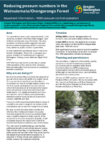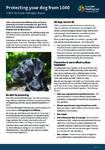WARNING – 1080 possum carcasses, Ōrongorongo River
23 September 2025 – Heavy rain overnight may have washed possum carcasses, poisoned with 1080, down the Ōrongorongo River following the recent 1080 operation in the Wainuiomata-Ōrongorongo Forest. We urge dog owners to keep their dogs away from the Ōrongorongo River and Wainuiomata Beach until council staff have checked for, and removed, dead possums poisoned with 1080. People are not at risk from poisoned carcasses.
This warning may be in place for up to four months.
Update - August 2025
On 15 August, GW and Wellington Water completed an aerial application of 1080 in the Wainuiomata Regional Park and the Wainuiomata/Ōrongorongo Water Collection Area. For 6 months, dogs aren't permitted on Nikau Track. Dogs on leads are welcome on Gums Loop, Sledge Track, Lower Dam Walk and Tana Umanga Track.
The biggest threat to native wildlife in the Wellington Region is introduced predators such as rats, possums and stoats.
We face a choice; let predators reach out of control numbers, or manage them to protect our native species, primary production sector and social wellbeing.
Current 1080 operations
Wainuiomata/Orongorongo 1080 operation – August 2025
On Friday 15 August 2025, Greater Wellington and Wellington Water completed an aerial possum control operation in the Wainuiomata Regional Park and the Wainuiomata/Orongorongo Water Collection Area, using the pesticide, sodium fluoroacetate (1080).
The operational area covered approximately 7,200 hectares, located in the Remutaka Ranges, east of Wainuiomata (see map below). The area includes the Wainuiomata/Orongorongo Water Collection Area, where no public access is permitted, and Wainuiomata Regional Park.
All land within the approved operational area is owned by Greater Wellington. Most of it is managed as a source of water for treatment and supply to Wellington, Porirua, Lower Hutt and Upper Hutt cities.
OSPRI NZ had approval to undertake an aerial 1080 operation in this area in 2024. However, this operation did not proceed due to unsuitable weather conditions.
The key objective for this proposed 1080 operation is to preserve one of our most important Key Native Ecosystem (KNE) sites in the region by removing possums, as well as rats and stoats.
The Wainuiomata/Orongorongo Water Collection Area is made up of one of the largest and most pristine lowland forests in the lower North Island. It is also a significant habitat for native bird species such as tītipounamu (rifleman), kākāriki, pōpokatea (whitehead), koekoeā (long-tailed cuckoo) and kiwi, all of which are threatened by possums.
For 6 months, dogs are not permitted on the Nikau Track. Dogs on leads are welcome on Gums Loop, Sledge Track, Lower Dam Walk and Tana Umanga Track.
For more information, read the operation factsheet:
Reducing possum numbers in the Wainuiomata/Orongorongo Forest

Important information – 1080 possum control operation
Greater Wellington and Wellington Water Limited (WWL) are undertaking an aerial possum control operation in the Wainuiomata Regional Park and the Wainuiomata/Orongorongo Water Collection…
Read more here

date_range Published 21 May 2025
Download now (PDF 1.7 MB) get_appUsing 1080
The biodegradable pesticide sodium fluoroacetate (or 1080) is one of the many methods we use to manage the array of predators within the Wellington Region. 1080 has been proven over many years to reduce predator numbers safely, with no adverse impact on the environment or human health.
We use aerial 1080 for controlling predators in areas which are rugged and/or hard to reach, making them difficult to control through other forms of ground control.
What we know about 1080
- It is highly soluble and does not accumulate or leave permanent residues in soil, water or animals
- It is found in many plants around the world including New Zealand’s native puha
- Bird nesting success rate dramatically improves after the use of 1080
- Many native trees and plant species show significantly better growth and survival after an aerial 1080 operation
- It does not kill or harm fish
- Local health authorities apply strict conditions to aerial operations so that drinking water supplies are not contaminated and that the public is informed when and where operations are to be undertaken
- Its safety has been confirmed through testing water samples following 1080 aerial operations. Several thousand samples have been tested over many years
Planning and permissions
Operations are subject to strict safety, quality-assurance and monitoring requirements. Helicopters are equipped with Global Positioning System (GPS) navigational technology to ensure bait is accurately placed within agreed operational areas, and identified ‘exclusion zones’ are avoided.
The use of 1080 requires consent from the Medical Officer of Health (MOH). It also must comply with both the Hazardous Substances & New Organisms Act and the Resource Management Act.
Control method
First, non-toxic tan-coloured “pre-feed” cereal pellets are sown by helicopter. This gives possums a taste for cereal pellets, encouraging them to consume the 1080 pellets sown at a later date making the operation more effective.
About seven to ten days after the non-toxic pellets are sown, helicopters will sow cereal pellets containing the biodegradable pesticide sodium fluoroacetate (1080).
Why are we using 1080?
Aerial control is particularly suited for large areas with rugged terrain. 1080 is a highly effective, cost-efficient and safe method of controlling mammalian pests, particularly possums, rats and stoats.
Rats will die when they consume possum baits, while stoats will be killed when they consume the carcasses of poisoned rats and possums. A reduction in these introduced predators will further protect native plants and birds.
In June 2011, the Parliamentary Commissioner for the Environment strongly endorsed the continued use of 1080 in New Zealand.
Safe drinking water
1080 is an organic, water soluble and biodegradable substance that is readily broken down by bacteria and other micro-organisms in the environment. Local health authorities apply strict conditions to aerial operations so that drinking water supplies are not contaminated. Safety has been confirmed by tests on several thousand water samples taken after aerial 1080 operations over many years.
Get in touch
- Phone:
- 0800496734
- Email:
- info@gw.govt.nz

